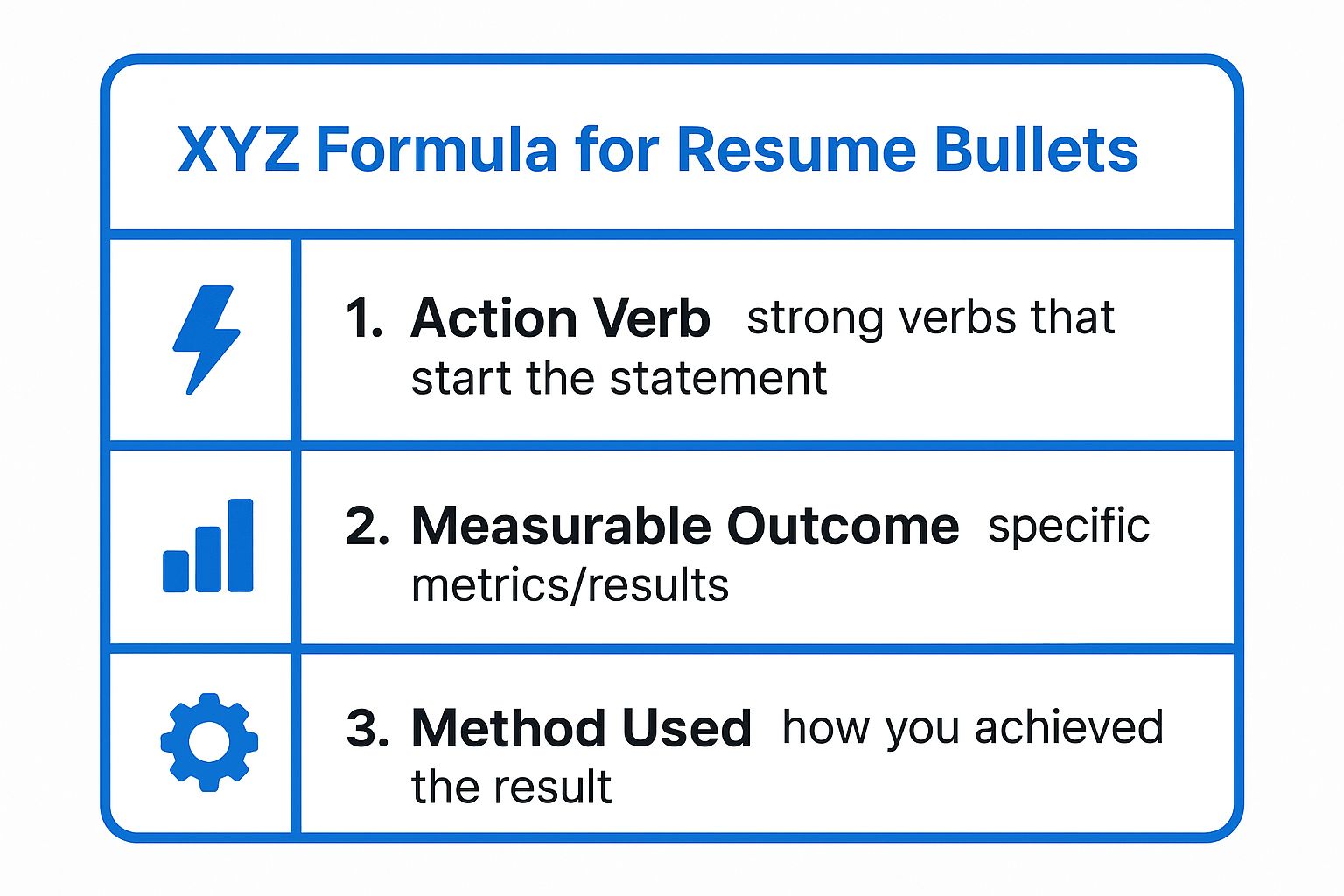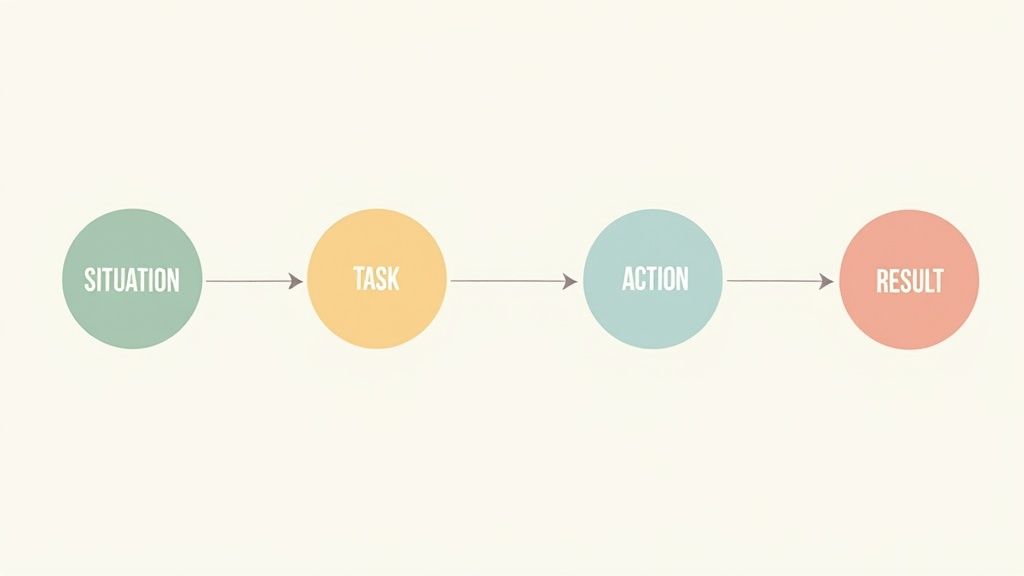8 Killer Resume Bullet Points to Land an Interview
- Alex Khamis

- Oct 5
- 10 min read
Updated: Oct 6
Let's be blunt. Your resume is not a list of your job duties. It’s a sales pitch, and your bullet points are the headline.
Too often, they’re wasted on vague phrases. "Responsible for managing social media" tells a hiring manager absolutely nothing of value. It's a space-filler.
Powerful resume bullet points are the difference between an interview and the trash folder. They must show impact, prove your worth with numbers, and sell you in seconds.
This guide cuts the fluff. We'll break down the exact formulas to write bullet points that grab a recruiter's attention and won't let go.
We’ll cover proven frameworks like:
The classic XYZ formula (Action + Task + Result)
Storytelling with the STAR and CAR methods
Using hard numbers to prove your worth
Problem-solution points that show you can think
By the end, you'll know how to turn every boring duty on your resume into a compelling reason to hire you. Let's get to it.
1. Action Verb + Task + Result (The XYZ Formula)
This is the gold standard for a reason. Popularized by Google’s hiring teams, the XYZ Formula is a simple, repeatable way to show what you did and why it mattered.
The formula is straightforward: Accomplished [X] as measured by [Y], by doing [Z]. This structure forces you to connect your actions to a real business result.
How to Use It
Start with a strong action verb. Describe the task. Then, most importantly, state the result. This turns a passive duty into an actual achievement.
Check out these examples:
Increased customer satisfaction scores by 35% (from 72% to 97%) by implementing a new customer feedback system and training program.
Reduced operational costs by $150,000 annually by streamlining the supply chain process and negotiating new vendor contracts.
Grew social media engagement by 250% in 6 months by developing a content calendar and launching targeted campaigns.
The infographic below sums it up.

This visual shows how each piece builds a powerful statement. The "how" you did it provides crucial context, making the result more believable and impressive.
Your Action Plan
Always start with a strong action verb. If your bullet point begins with "Responsible for," delete it and start over. It’s a waste of space. For a list of better words, check out these top resume action words to land interviews.
2. STAR Method Bullets (Situation, Task, Action, Result)
While XYZ is great for impact, the STAR method tells a mini-story. It's an interview technique you can adapt for your resume to show how you handle real-world challenges.
The structure is Situation, Task, Action, and Result. You set the scene (Situation), define your goal (Task), explain what you did (Action), and show the outcome (Result).

How to Use It
The key here is brevity. Don't write a novel. The Situation and Task just set the stage. The Action and Result are the real stars of the show.
Here’s how it looks in practice:
Faced with a 40% employee turnover rate, designed and launched a mentorship program that reduced attrition to 12% within one year.
When Q2 sales declined 20%, pivoted marketing strategy based on customer data, driving a 45% revenue growth in Q3.
Identified a critical security vulnerability; led a cross-functional team to implement urgent fixes, preventing a potential $2M in fraudulent losses.
The context makes your achievement even more impressive. You didn't just get a result; you solved a real problem to get it.
Your Action Plan
Be ruthless with your editing. The Situation and Task should be short and to the point. Use phrases like "Faced with," or "When X happened" to set the scene quickly.
3. CAR Method (Challenge, Action, Result)
The CAR method is a stripped-down version of STAR. It's punchier and focuses on your ability to overcome obstacles. You faced a Challenge, took Action, and got a Result.
This is perfect for showing initiative. It frames you as someone who doesn't wait to be told what to do but actively seeks out and solves problems.
How to Use It
Start with the problem. What was broken? Then explain what you did to fix it, and end with the positive outcome. It's a simple, powerful story.
Here are some solid examples:
Challenged with a messy inventory system causing $50K in monthly losses, implemented new tracking software, eliminating all discrepancies within three months.
Addressed declining team morale (satisfaction at 60%), introduced weekly one-on-ones, improving the score to 89% in the next quarterly survey.
Overcame a 6-month project delay, reorganized the workflow and reallocated resources, delivering the final product 2 weeks ahead of the revised deadline.
This approach positions you as a problem-solver, not just a task-doer. That’s a crucial distinction for any hiring manager.
Your Action Plan
Pick challenges that are relevant to the job you want. The problem you describe should be a real business issue. This format is a great way to prove you can handle pressure.
4. Quantified Achievement Bullets
Numbers don't lie. This approach leads with your most impressive metric to immediately grab a recruiter’s attention. It's hard data, not fluff.
Quantified bullets are your best friend in roles like sales, finance, or marketing. They provide instant, scannable proof of your value. It’s showing, not just telling.
How to Use It
Frame your success around a specific, compelling number. This could be revenue, cost savings, efficiency gains, or people impacted. Make the number the star.
See how these examples pop off the page:
$2.5M: Generated in new client revenue in one year, exceeding the annual target by 40% through a new acquisition strategy.
150+: Employees trained across 5 national locations on a new CRM, leading to a 98% adoption rate within 60 days.
18%: Reduction in departmental spending from a $5M budget, achieved by optimizing vendor contracts without any staff cuts.
Numbers act like magnets for a recruiter's eyes. To learn how to find these numbers, explore these powerful accomplishment examples for your resume.
Your Action Plan
Dig through your past performance reviews and project reports. Find any metric you can. Use symbols like $, %, and + to make the numbers stand out. For more on this, check out this guide to crafting powerful resume accomplishments.
5. Skills-Focused Bullets
This is a smart move for career changers or anyone targeting a job that requires specific skills. You don't just list your skills; you prove you can use them.

This method helps you get past the automated resume screeners (ATS) that are looking for keywords from the job description. It connects your abilities directly to business outcomes.
How to Use It
Name the skill, then immediately show how you used it to get a result. This directly answers the hiring manager's question: "Can you actually do this?"
Here are some crystal-clear examples:
Utilized Python and SQL to automate data analysis, cutting report generation time from 8 hours to just 45 minutes.
Applied project management (Agile, Scrum) to coordinate 3 product launches, all delivered on schedule and under budget.
Leveraged strong negotiation skills to secure 15 new vendor partnerships, saving the company $200K annually.
This tactic makes it impossible for them to miss that you have the exact skills they’re looking for. It’s like checking off boxes on their wish list.
Your Action Plan
Scan the job description for mandatory skills. Use their exact language in your bullet points. Don't just list a skill; prove it. To learn how to show off other abilities, see how to list soft skills on your resume.
6. Problem-Solution Bullets
This is a more advanced move that works like a mini-case study. You show you can identify a business problem, figure out a solution, and make it happen.
This format screams "strategic thinker." It shows you're not just waiting for tasks but are actively looking for ways to improve the business. This is what leaders do.
How to Use It
State the problem, then present your solution and the impact. This simple narrative hook grabs a recruiter’s attention by presenting a clear conflict and resolution.
Here's how to frame it:
Problem: High customer churn (35%) was hurting revenue. Solution: Developed a targeted retention program, reducing churn to 18% and stabilizing income.
Recognized the project approval process was a bottleneck (averaging 10 days). Redesigned the workflow, cutting approval time to just 2 days.
Identified a gap in the market for an eco-friendly product. Proposed and launched the new line, generating $800K in its first year.
This approach tells a complete story. It proves you can spot pain points and, more importantly, that you have the initiative to fix them.
Your Action Plan
Identify a business problem you solved. Use strong verbs like “Recognized,” “Diagnosed,” or “Identified.” Keep the problem description short. The focus should be on your solution and the result.
7. Comparative Bullets (Before/After)
This technique makes your impact impossible to miss. You show the transformation you drove by contrasting the "before" state with the "after" state. It's incredibly persuasive.
This format gives the hiring manager a clear picture of the change you created. It’s the difference between saying you improved something and showing the dramatic shift.
How to Use It
Frame your accomplishment as a journey from a clear starting point to a much better end point. You are painting a picture of progress, with you as the hero.
Look at these powerful examples:
Transformed an underperforming sales territory from $500K annually (lowest in region) to $2.1M (top 10%) in 18 months.
Improved website load time from 8.5 seconds to 1.2 seconds, resulting in a 65% decrease in bounce rate and a 20% lift in conversions.
Restructured a customer service team, slashing average response time from 48 hours to 4 hours while boosting customer satisfaction from 67% to 94%.
This is undeniable proof of your performance. It’s raw, data-driven, and extremely effective.
Your Action Plan
Look for your most dramatic improvements. Use clear language like "from X to Y" or "reduced from... to...". Always include a timeframe to show your efficiency. One warning: make sure the "before" state wasn't your fault. This is for fixing inherited problems.
8. Scope and Scale Bullets
These bullets convey the sheer size of your responsibilities. Instead of one outcome, they paint a picture of the complexity and significance of your role.
This format is crucial for leaders and managers. It answers the question: "Can this person handle the scale of our company?" It provides context that makes your other achievements more impressive.
How to Use It
Give the hiring manager a sense of your operational capacity. Mention team sizes, budgets, number of locations, or users impacted. You are quantifying your leadership abilities.
These examples show how it's done:
Directed a global launch across 15 countries for a $30M product line, coordinating a cross-functional team of 50+ professionals.
Managed a portfolio of 200+ client accounts representing $50M in annual recurring revenue across multiple sectors.
Oversaw daily operations for 3 retail locations with 75 staff, serving over 15,000 customers weekly and generating $12M annually.
The power comes from layering multiple data points. A big budget is good. A big team is good. Managing a big team and a big budget is executive-level impressive.
Your Action Plan
Think broadly about your work's impact. Combine several metrics to show both breadth and depth. Think in terms of people, budget, geography, and volume. To align this with what recruiters want, learn how to tailor your resume to the job posting.
Resume Bullet Point Styles Comparison
Method / Formula | Implementation Complexity | Resource Requirements | Expected Outcomes | Ideal Use Cases | Key Advantages |
|---|---|---|---|---|---|
Action Verb + Task + Result (XYZ) | Moderate – requires quantifiable metrics | Data collection & research | Clear, measurable achievements with methods | Metric-driven roles, tech companies, ATS-focused | Quantifies impact; easy to scan; preferred by ATS |
STAR Method (Situation, Task, Action, Result) | High – needs concise storytelling | Strong writing skills | Contextualized stories showing problem-solving | Complex achievements; interview preparation | Compelling stories; highlights critical thinking |
CAR Method (Challenge, Action, Result) | Moderate – simpler than STAR | Some context and action details | Focused problem-solving and results | Leadership roles; initiative-focused achievements | Punchy, resilient-focused; easy to remember |
Quantified Achievement Bullets | Low to moderate – emphasizes numbers | Access to metrics | Impactful, numbers-driven results | Sales, finance, any metric-driven industry | Grabs attention quickly; strong visual impact |
Skills-Focused Bullets | Low – lists skills with context | Knowledge of job keywords | Shows relevant competencies with some evidence | Career changers, recent grads, ATS-heavy roles | ATS optimization; links skills to outcomes |
Problem-Solution Bullets | Moderate – balances brevity and impact | Strategic thinking examples | Demonstrates problem identification + innovation | Senior, management, consulting, strategy roles | Shows business acumen; memorable case-like bullets |
Comparative Bullets (Before/After) | Moderate – needs clear baseline and results | Data on before & after states | Highlights transformation and improvement | Turn-around, process improvement, sales roles | Makes impact obvious; strong contrast |
Scope and Scale Bullets | Low to moderate – focus on size & complexity | Metrics on teams, budget, reach | Communicates scale and responsibility | Management, leadership, program/project management | Conveys responsibility level; readiness for growth |
Now, Go Write Bullets That Can't Be Ignored
You now have a full playbook for writing killer resume bullet points. We've moved beyond generic advice and into specific formulas that make hiring managers actually read your resume.
The difference between a resume that lands interviews and one that gets deleted often comes down to this one thing. Are your bullets a boring list of duties, or are they compelling, data-backed proof of your accomplishments?
Your New Toolkit
Let's review the core strategies. Mix and match these frameworks to best tell your professional story.
Quantify Everything: Numbers cut through the noise. Find them and use them. They are your proof.
Show, Don't Just Tell: Instead of saying you're a "problem-solver," use the Problem-Solution method to prove it with a real example.
Context is King: Scope and Scale bullets are crucial. They show you can handle the complexity of the roles you're applying for.
Structure Your Stories: The XYZ, STAR, and CAR formulas are your secret weapons. They make your wins easy to understand and remember.
Mastering these techniques will fundamentally change how you look on paper. You’re no longer just an applicant; you’re a candidate making a clear business case for why you are the solution.
The Real Goal — Make Their Decision Easy
Every single bullet point on your resume should answer one question: "Why should I hire you?"
Your resume isn't your life story. It's an advertisement, and you are the product. Each bullet is a headline for your skills, your impact, and your value.
Your job now is to apply these frameworks to your own career. Dig through old performance reviews. Find the data. Uncover the "before and after" stories. Frame your work as valuable results you created for your employer.
This is how you write resume bullet points that get you the interview.
Tired of staring at a blank page or feeling like your accomplishments aren't coming across? The experts at Final Draft Resumes specialize in transforming job duties into compelling, data-driven bullet points that capture attention. Let us help you build a resume that makes an undeniable impact.
Author
Alex Khamis is a Certified Professional Resume Writer and Managing Partner at Final Draft Resumes and Resumatic.
He has over 15 years of experience across career services and business communications. He's helped people land roles at companies like The Walt Disney Corporation and Microsoft.

Comments